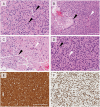Diagnostics and prospective outcome of a diffuse glioneuronal tumor with oligodendroglioma-like features and nuclear clusters after surgical resection (DGONC): a case report
- PMID: 36479060
- PMCID: PMC9719366
- DOI: 10.1093/noajnl/vdac170
Diagnostics and prospective outcome of a diffuse glioneuronal tumor with oligodendroglioma-like features and nuclear clusters after surgical resection (DGONC): a case report
Keywords: brain tumor; molecular diagnostics; patient outcomes.
Figures



References
-
- Deng MY, Sill M, Sturm D, et al. . Diffuse glioneuronal tumour with oligodendroglioma-like features and nuclear clusters (DGONC) - a molecularly defined glioneuronal CNS tumour class displaying recurrent monosomy 14. Neuropathol Appl Neurobiol. 2020;46(5):422–430. - PubMed
LinkOut - more resources
Full Text Sources
